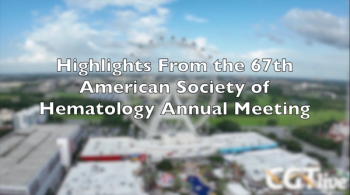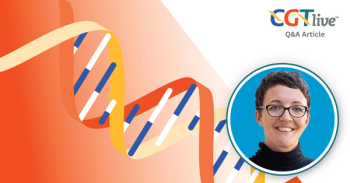
Commentary (Ryan/Clark): Management of Anal Cancer in the HIV-Positive Population
Kauh and colleagues nicely outlinethe major problems facingclinicians who treat humanimmunodeficiency virus (HIV)-positivepatients with squamous cell carcinomaof the anus. This is a highly curabledisease with combined-modality therapy,though the HIV-positive populationpresents unique challenges. Weagree with the approaches outlined bythe authors and would also like to emphasizeseveral principles in the managementof anal cancer.
Kauh and colleagues nicely outline the major problems facing clinicians who treat human immunodeficiency virus (HIV)-positive patients with squamous cell carcinomaof the anus. This is a highly curable disease with combined-modality therapy, though the HIV-positive population presents unique challenges. We agree with the approaches outlined by the authors and would also like to emphasize several principles in the management of anal cancer. Lessons From Randomized Studies
The Anal Cancer Trial Working Party of the United Kingdom Coordination Committee on Cancer Research randomized 585 patients to receiveeither radiotherapy alone (45 Gy of external beam with either a 15-Gy external beam boost or a 25-Gy brachytherapy boost) or similar radiotherapy with concurrent fluorouracil (5-FU) and mitomycin.[1] After a median follow-up of 42 months, patients assigned to receive chemoradiation therapy had a reduced likelihood of local failure (61% vs 39%, P = .0001) and dying from anal cancer (28% vs 39%, P = .02) when compared to the cohort managed with radiation therapy alone. There was,however, no significant difference in overall survival. Severe morbidity was significantly worse for patients receiving chemoradiation. The European Organisation for Research and Treatment of Cancer performed a very similar trial and established that chemoradiation, when compared to radiation therapy alone, is associated with a higher pathologic complete remission rate (80% vs 54%), an 18% higher 5-year locoregional control rate (P = .02), a 32% higher colostomy-free rate (P = .002), and an improved progression-free survival (61% vs 43%, P = .05).[2] Overall survival, however, was not significantly different. The conclusions from these two studies are as follows: (1) chemoradiation improves local control and colostomy-free survival, (2) chemoradiation is associated with more toxicity, and (3) chemoradiation is not necessarily associated with better overall survival, although neither of these studies was designed to answer this question. The Radiation Therapy Oncology Group and the Eastern Cooperative Oncology Group randomized 310 patients with anal cancer of any tumor or nodal stage to receive combinedmodality therapy with or without mitomycin.[ 3] The probability of both overall survival and colostomy-free survival after 5 years was not significantly different. The addition of mitomycin, however, resulted in a statistically significant improvement in disease-free survival after 5 years (67% vs 50%, P = .006). Grade 4 myelosuppression and grade 4 nonhematologic toxicities of the gastrointestinal tract, mucous membranes, and skin were significantly more common in the patients allocated to receive mitomycin (23% vs 7%, P < .001). In addition, fatal neutropenic sepsis (4 patients vs 1 patient, P ≤ .001) was significantly more common in the patients receiving mitomycin. Unanswered Questions
It is important to note what was not answered by these studies. First, overall survival has not been shown to be significantly better with chemoradiation compared with radiation therapy alone. Thus, we are potentially subjecting patients to higher levels of toxicity in order to improve local control and colostomy-free survival but not overall survival. Second, the reason that is often given for a lack of survival difference is that salvage abdominoperineal resection can cure patients with recurrent or residual disease. However, several recent studies suggest that only a minority of patients with persistent or recurrent disease will be cured by salvage abdominoperineal resection.[4-6] Lastly, these three studies used a radiation dose of 45 to 50.4 Gy but the optimal radiation dose has not been established. Higher doses of radiation appear to be associated with better efficacy but at a cost of more early and late toxicity, including the need for colostomies to treat anal stenoses and ulcerations.[7] The Nigro regimen used lower doses of radiation initially. This approach may need to be reevaluated in patients at high risk for toxicity.[8] Applying Lessons Learned to HIV Patients
Several small institutional experiences have suggested that patients with HIV tend to have higher toxicity rates and worse outcomes than non- HIV-positive patients.[9,10] The reasons for this are not entirely clear, but may be related to the level of immunodeficiency as measured by CD4 count. One institutional experience suggests that toxicity may be better in the era of highly active antiretroviral therapy (HAART), perhaps due to the enhanced level of immune function. The following are several suggestions for managing patients with HIV:
- In conjunction with HIV specialists, make sure that patients are on optimal HAART.
- Consider delaying the start of chemoradiation for 1 to 2 months for patients who have not been onHAART in order to allow for improved immune function. Anal cancers tend to be slowly growing lesions; a 1- to 2-month delay in therapy should not significantly impact outcome.
- Consider a diverting colostomy for patients at high risk of local complications during therapy, eg, severely immunocompromised patients and patients with large primary lesions.
- Consider omitting mitomycin for immunocompromised patients.
- Consider enrolling HIV-positive patients into trials evaluating different treatment techniques, eg, intensity- modulated radiation therapy, smaller radiation fields, and integration of local excision.[11]
Disclosures:
The authors have no significant financial interest or other relationship with the manufacturers of any products or providers of any service mentioned in this article.
References:
1. UKCCCR: Epidermoid anal cancer: Results from the UKCCCR randomised trial of radiotherapy alone versus radiotherapy, 5-fluorouracil, and mitomycin. UKCCCR Anal Cancer Trial Working Party. UK Co-ordinating Committee on Cancer Research. Lancet 348:1049- 1054, 1996.
2. Bartelink H, Roelofsen F, Eschwege F, et al: Concomitant radiotherapy and chemotherapy is superior to radiotherapy alone in the treatment of locally advanced anal cancer: Results of a phase III randomized trial of the European Organization for Research and Treatment of Cancer Radiotherapy and Gastrointestinal Cooperative Groups. J Clin Oncol 15:2040-2049, 1997.
3. Flam M, John M, Pajak TF, et al: Role of mitomycin in combination with fluorouracil and radiotherapy, and of salvage chemoradiation in the definitive nonsurgical treatment of epidermoid carcinoma of the anal canal: Results of a phase III randomized Intergroup study. J Clin Oncol 14:2527-2539, 1996.
4. Akbari RP, Paty PB, Guillem JG, et al: Oncologic outcomes of salvage surgery for epidermoid carcinoma of the anus initially managed with combined modality therapy. Dis Colon Rectum 47:1136-1144, 2004.
5. Allal AS, Laurencet FM, Reymond MA, et al: Effectiveness of surgical salvage therapy for patients with locally uncontrolled anal carcinoma after sphincter-conserving treatment. Cancer 86:405-409, 1999.
6. Pocard M, Tiret E, Nugent K, et al: Results of salvage abdominoperineal resection for anal cancer after radiotherapy. Dis Colon Rectum 41:1488-1493, 1998.
7. Allal AS, Mermillod B, Roth AD, et al: Impact of clinical and therapeutic factors onmajor late complications after radiotherapy with or without concomitant chemotherapy for anal carcinoma. Int J Radiat Oncol Biol Phys 39:1099-1105, 1997.
8. Leichman L, Nigro N, Vaitkevicius VK, et al: Cancer of the anal canal. Model for preoperative adjuvant combined modality therapy. Am J Med 78:211-215, 1985.
9. Hoffman R, Welton ML, Klencke B, et al: The significance of pretreatment CD4 count on the outcome and treatment tolerance of HIVpositive patients with anal cancer. Int J Radiat Oncol Biol Phys 44:127-131, 1999.
10. Stadler RF, Gregorcyk SG, Euhus DM, et al: Outcome of HIV-infected patients with invasive squamous-cell carcinoma of the anal canal in the era of highly active antiretroviral therapy. Dis Colon Rectum 47:1305-1309, 2004.
11. Hu K, Minsky BD, Cohen AM, et al: 30 Gy may be an adequate dose in patients with anal cancer treated with excisional biopsy followed by combined-modality therapy. J Surg Oncol 70:71-77, 1999.
Newsletter
Stay at the forefront of cutting-edge science with CGT—your direct line to expert insights, breakthrough data, and real-time coverage of the latest advancements in cell and gene therapy.































